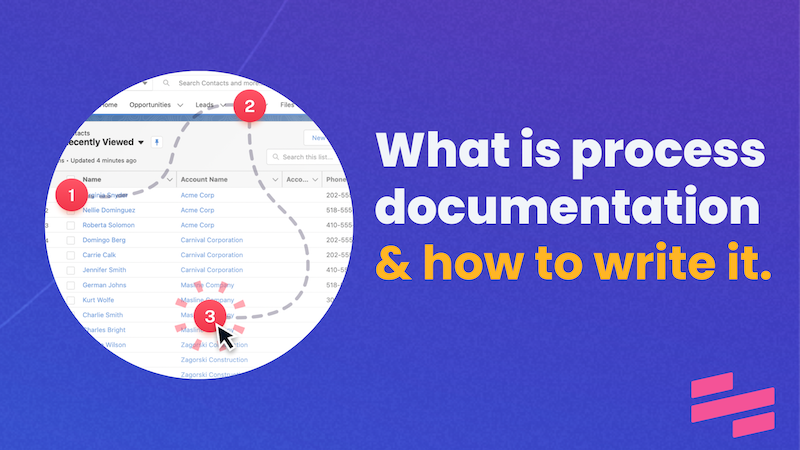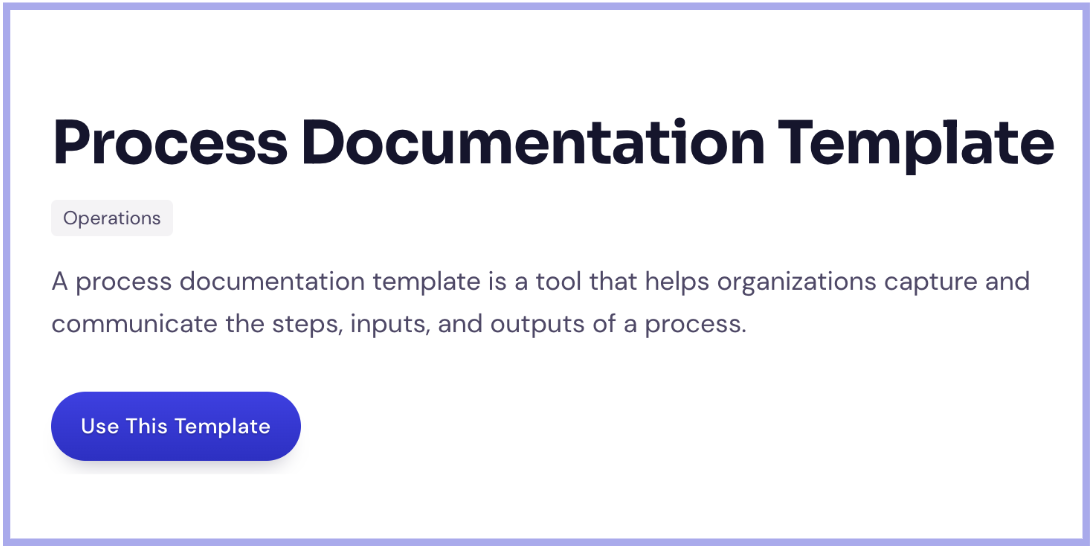Introduction
 |
Every day, companies are losing too much time to mismanaged processes.
Process documentation helps employees deliver work fast—without sacrificing quality.
In his book The E-myth Revisited: Why Most Small Businesses Don’t Work, Michael Gerber states,
"Once you create your company's process documentation, it's easier to empower your low-skilled workers to easily complete tasks and tick off boxes on their checklists."
Process documentation is a big part of enabling employees to deliver high-quality work.
For instance, highly-skilled professionals like surgeons and pilots still rely on process documentation to provide error-free service.
For employees like these, process documentation can make or mar — it could result in life or death. This is why implementing checklists reduced mortality by 24 percent in Rwandan hospitals and reduced major complications by 60 percent.
In short, process documentation can:
- Help employees work efficiently and independently.
- Ensure consistent and reliable results.
- Lay the foundation for innovation and process improvements.
What is process documentation?
Process documentation is a written breakdown of a process or activity from the beginning to the end result. Process documents usually include annotated screenshots or illustrations to outline each step clearly, along with a list of resources.
These guides explain the "how" of procedures or business processes.
By documenting a process, we preserve the standardized, ideal way of carrying out that task. You can easily
Types of process documentation
Different types of process documentation serve different business functions. Here are the top process documentation examples you'll likely run into in the workplace.
- Step-by-step guides.
- Standard operating procedures.
- Runbooks.
- Instruction manuals.
- Checklists.
- Flowcharts and diagrams.
1. Step-by-step guides
 |
A step-by-step or how-to guide is the simplest type of process documentation. These internal or external how-tos list out each step in a task.
Step-by-step guides include:
- A brief task overview.
- A list of steps with short description for each.
- Images, screenshots or GIFs.
- The expected outcome.
Unlike larger project documentation, step-by-step guides are best for running through shorter, consumable processes. We recommend organizing related process guides in a training manual or internal knowledge base.
2. Standard operating procedures
 |
Standard operating procedures (SOPs) are formal process documents mostly used in regulated industries like accounting, manufacturing or healthcare.
These documents usually include safety precautions, quality control measures and specific protocols to follow in case of emergencies.
A typical SOP will have the following sections:
- Purpose and scope.
- Roles and Responsibilities.
- Procedural instructions
- Relevant policies and regulations
3. Runbooks
 |
A runbook is a sometimes automated form of documentation that outlines how a process specific to IT teams.
Runbooks usually include:
- A process overview.
- A list of who has access and authorization.
- Installation and deployment steps.
- Instructions for activating monitoring system data.
- Disaster recovery strategies.
- Configuration, analytics or other system information.
4. Instruction manuals
Instruction manuals (also called user manuals) are customer-facing documents that walk them through how to build or use your product. They often include:
- An overview.
- A list of tools or resources.
- Step-by-step instructions.
- Illustrations or screenshots.
- A description of the expected outcome or result.
5. Checklists
 |
A checklist is particularly useful for tasks that don't need to be done in a particular order or require additional context.
You probably use a standard checklist to tick off your daily to-do tasks. They're also often visible in service industries to describe opening and closing procedures.
6. Flowcharts and diagrams
 |
Flowcharts, or process maps, are a visual breakdown of processes. We often uses these in situations with several different options and paths that a user might take.
The flowchart will outline the user journey and showcase different results.
Flowcharts usually include:
- A mapped breakdown of each step in the journey.
- Arrows indicating different options.
- Symbols associated with actions.
- If/then choice indicators.
Why process documentation is important
If you’ve ever tried to bake a cake without a recipe, you understand the importance of process documentation. Without specific steps to follow, your results will be inconsistent at best.
A failed cake isn’t the end of the world. Maybe you lose a few dollars and hours, and your sweet tooth is unsatisfied. But if baking cakes is your job — and your employer has invested thousands (or millions) in perfecting the cake-baking process — you have a problem.
Properly developed and implemented documented processes provide a reliable and audit-worthy record of how an organization or team performs different tasks.
1. Process documentation protects institutional knowledge
So much of a company's institutional knowledge lives in the heads of its go-to people. Use process documentation to establish quality standards to streamline employee performance and outputs.
This will keep up business continuity when an employee leaves or goes on vacation by ensuring you have a record of your employees' protocols that are compliant, consistent and approved.
Creating process documentation is the first step to achieving consistent excellent outcomes.
The right process document will also maximize compliance and consistency for every workflow. So your team will make less (potentially costly) mistakes.
2. Process documentation helps you train employees
With process documentation, you can easily train new hires on a company’s processes, systems and tools.
Existing team members can also reference the same documents to perform certain tasks, take on new responsibilities, refresh their knowledge of their current roles or even ensure they know all of the steps of a specific task.
Not only does this ensure that everyone is on the same page, it also:
- Improves overall team consistency.
- Enhances collaboration and communication.
- Reduces the time spent on developing and implementing new processes.
- Strengthens teams by clearly designating each employee’s responsibility.
3. Process documentation achieves 30-50 percent productivity gains
Business Process Management, otherwise known as BPM, is a combination of methods used to manage a company's business processes — one is process documentation.
Adopted by many companies globally, process documentation has proven to be one of the biggest drivers for increasing employee productivity and reducing waste. Some of the important ways in which process documentation increases productivity include:
- Reduces the time spent on repetitive tasks.
- Ensures that the right people are doing the right jobs.
- Allows for better team collaboration.
Process documentation can significantly increase your company's productivity levels when implemented correctly. Forrester reports that BPM projects can deliver between 30-50 percent productivity gains for processes involving primarily back office and clerical staff and can typically deliver 15-30 percent productivity gains for processes involving knowledge workers.
4. Process documentation reduces distractions and the risk of operational damage
In a study from the University of California Irvine, researchers led by Gloria Mark shadowed workers on the job, studying their productivity. Here's what study lead Gloria Mark told Fast Company about their research:
"We found about 82 percent of all interrupted work is resumed on the same day. But here's the bad news — it takes an average of 23 minutes and 15 seconds to get back to the task."
You might think 23 minutes isn’t much of a big deal until you realize that even if your team members get distracted a few times during the day, the amount of time they lose as they struggle to get back to their happy work mode should be taken seriously. Let me do the maths for you:
Let’s say you head a team of ten DevOps engineers…
If one of them gets distracted three times daily, they’re losing an hour of work.
If 10 of them get distracted three times daily, they’re losing 10 hours of work. 10 hours!
You might wonder, "How does this cause operational damage?" Good question!
Here’s an example.
As a DevOps manager, if your team doesn’t have process documentation for a bug testing process when your company releases a software update, your team members would most likely reach out to one another or even you — asking for tips on how to perform the task.
While waiting for answers, they might most likely be interrupted or even leave their desks completely to do something else. There’s also a high chance that they will make mistakes, resulting in costly operational damage since the answers they got were collated from “chats” and not a documented process.
Here’s my recommendation: When creating your process documentation, highlight the major areas where mistakes are commonly made so that your employees are aware and less likely to make them.
How to write process documentation in 6 easy steps
Ready to start documenting processes for your team? Follow these six steps to write process documentation.
1. Define your goal(s)
Before writing process documentation, the first thing to do is to determine what you want to achieve. Is it...
- To onboard new DevOps hires?
- To reduce the time your DevOps team spends searching for information?
- Is it to eliminate the guesswork for certain tasks
- OR do you want to enhance communication and collaboration?
Make your goals clear. Defining your objectives will help you determine which process to document first.
2. Identify your process documentation stakeholders
Process documentation should be a team activity. No one person can put together an entire organization’s processes. The same applies to teams. Rather, gather a team of documentation experts to lead your team’s process documentation.
Here, you’ll need to rely on technical writers or technical writing tools to ensure your process documentation is consistent and reliable.
Also, remember that the best person to document a process is someone who uses it daily—keep your mind open when deciding which stakeholders to involve in the project.
3. Use a process documentation tool or template
We recommend using a process documentation tool to help you quickly create, share and store your process documentation.
For example, Scribe is an AI-powered tool that writes process documentation for you.
It captures your screen to create a visual guide — including text, links and annotated screenshots.
Make as many guides as you need, then use Scribe Pages to combine your Scribes with video, images and AI-generated text.
Once you've identified your tool, you can create a standard process documentation format or template you and your team can use repeatedly.
4. Start writing your process documentation
Each process document should include the following
- Process name: Try to create and use a standard, clear nomenclature for all process documents.
- Process scope: Briefly explain what would be included in the process and what is not.
- Process materials: Identify the resources needed to complete the process.
- Process outputs: Name the results of the process once it’s completed.
- Step-by-step guide: Jot down each step in the process, including what triggers the process or detailing the outcomes and working backward.
- List of stakeholders: Include everyone involved in the process documentation, plus their roles and contact information.
5. Conduct a peer review
Ensure your documentation undergoes a peer review process before it is published.
It’s important to gather feedback from other necessary stakeholders who can gauge whether your process documentation is useful and if the processes are easy to follow.
For example, tools like Scribe offer a built-in feedback system, so you can easily edit process steps or even submit process documents for approval.
 |
6. Publish and audit your process document
Once the documentation is finalized, hit “publish” and make it available to your team and the rest of the organization (where applicable).
A good process documentation software enables you to publish private documentation open to only your employees and some selected people within the organization while protecting your documentation from unwanted visitors.
Ask your employees or team members for feedback regarding whether they found the documentation helpful and use it to make appropriate changes.
Who is involved in process documentation?
Here are all the roles involved in documenting processes in any organization:
- Process owners: those who manage the entire lifecycle of business process documentation. They are the starting point of this lifecycle, responsible for setting goals and overseeing resource allocation to ensure the results are aligned with overall expectations.
- Subject matter experts: those who provide process knowledge, expert insights and other inputs to make the documentation process a success.
- Technical writers: those who use templates and software to create the actual process document. They specialize in technical documentation and convert all the SME interviews and inputs into written content.
- Quality assurance executives: those who review all the docs for errors, accuracy and impact. They validate every document to make the content compliant and reliable.
- Other stakeholders: this can depend on your team structure and job titles.
Bigger companies also work with a change management team to quickly document any modifications in a process or strategy. Overall, these roles contribute to process documentation.
Process documentation best practices
Whether you’re starting process documentation from scratch or looking to improve your implementation approach, these process documentation best practices will take you a long way ahead:
- Review and update: As your processes evolve, make sure to update or create new documentation as needed. Look at your company roadmap and consider the need for documentation from both employees’ and users’ perspectives.
- Add visuals: Process documentation needs to be easy to read and understand. Visual elements such as flowcharts and screenshots help employees easily understand any process.
- Write to a specific audience: Make sure you know the main audience for each document and write in their language for maximum understanding. Seek consistent feedback and iterate the content to enhance clarity.
- Get hands-on experience: Go beyond your SMEs to get process details from employees directly involved in its execution. This will bring you more accurate ideas and insights.
- Create a knowledge base: Use a centralized knowledge management platform to make it easy to find information. A single source of docs cuts the hassle of searching through multiple platforms to answer a question.
Free process documentation template
Process documentation software like Scribe offers a centralized library of information that allows your team to build and access process documentation easily. Here's a free template you can start with today.
 |
Want to generate your own process documentation? Use Scribe for:
- Free auto-generated process documents — Build visual guides in seconds.
- Easy editing — allows the admin or editor to add flowcharts, videos, gifs and other visual elements.
- AI-powered search — Scribe allows you to easily search for specific information without wasting time.
- Sharing and collaboration — With Scribe, you can easily communicate and collaborate with team members on sharing documents and peer reviews.
- Organizing content — Process documents can easily be organized more clearly and filed under different, appropriate categories.
- Document redaction — Scribe allows you to search for and remove text, images, and other content containing private, sensitive, or confidential information.
Start building process documentation
We can't overstate the importance of creating process documentation.
It's not just a best practice; it's a necessity for companies that want to:
- Improve efficiency.
- Reduce errors.
- Achieve consistent, high-quality results.
So whether you're a small business or large enterprise, use our tips to start building and sharing process documentation today.
Generate visual process documents in half the time — for free!








